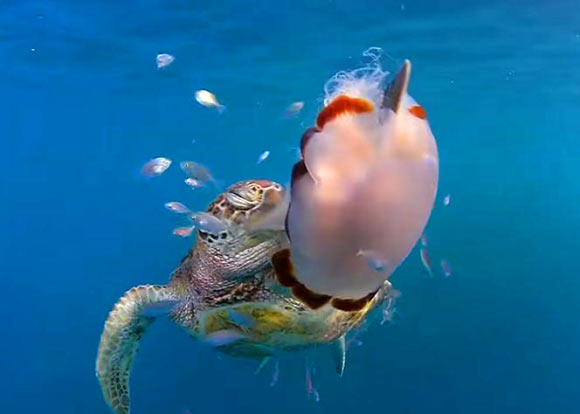According to a new study published online in the journal PeerJ, foraging marine turtles use flippers to handle prey despite the limbs being evolutionarily designed for locomotion.

A green turtle swiping the stinging jellyfish (Cyanea barkeri) in the water column at Hook Island, Queensland, Australia, taken June 2017. Image credit: Fujii et al, doi: 10.7717/peerj.4565.
The analysis by a team of Monterey Bay Aquarium researchers using crowd-sourced photos and videos finds widespread examples of behaviors such as a green turtle holding a jelly, a loggerhead rolling a scallop on the seafloor and a hawksbill pushing against a reef for leverage to rip an anemone loose.
Similar behaviors have been documented in marine mammals from walruses to seals to manatees — but not in marine turtles.
The in-depth examination of the phenomenon reveals the behavior is widespread and that this type of exaptation of flippers may have been occurring 70 million years earlier than previously thought.
“Marine turtles’ limbs have evolved mostly for locomotion, not for manipulating prey,” said study lead author Dr. Jessica Fujii.
“But that they’re doing it anyway suggests that, even if it’s not the most efficient or effective way, it’s better than not using them at all.”
The finding came as a surprise to the scientists, given marine turtles’ ancient lineage and the fact that the reptiles are considered to have simple brains and simple flippers.
The results also offer an insight into the evolution of four-limbed ocean creatures that raises questions about which traits are learned and which are hardwired.
“We expect these things to happen with a highly intelligent, adaptive social animal. With marine turtles, it’s different; they never meet their parents,” said senior author Dr. Kyle Van Houtan.
“They’re never trained to forage by their mom. It’s amazing that they’re figuring out how to do this without any apprenticing, and with flippers that aren’t well adapted for these tasks.”
_____
J.A. Fujii et al. 2018. Limb-use by foraging marine turtles, an evolutionary perspective. PeerJ 6: e4565; doi: 10.7717/peerj.4565







